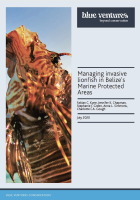Executive Summary
“For marine protected areas to function as conservation areas, it’s important that the biology and ecology be conserved to the highest level possible, and that now requires lionfish control.”
– James Morris (2014) in Nature.
Across the Caribbean, the invasion of red lionfish (Pterois volitans) poses a pervasive threat to marine ecosystems and coastal fishing communities. First recorded in Belize in 2008, lionfish have become well established across the country’s entire marine environment. Uncontrolled, invasive lionfish populations disrupt marine food webs, negatively impacting coral reef health and fisheries productivity, thereby undermining the resilience of coral reefs and reef-associated systems to global change. Basic data on lionfish populations are lacking from the majority of Belize’s marine reserves, which has made it impossible to develop, implement or evaluate lionfish management targets and action plans. This report presents the most thorough population census to date for invasive lionfish and associated native fish communities in Belize.
By developing specific management targets and thresholds for protected areas, using the best available science and the precautionary principle, MPA managers can prioritise sites, create removal targets and direct removal efforts only towards areas identified as vulnerable to the impacts of lionfish invasion. This is an important benefit for conservation practitioners seeking to allocate resources in a way that sustains sufficient invasive species control over the long term, in priority habitats.

















